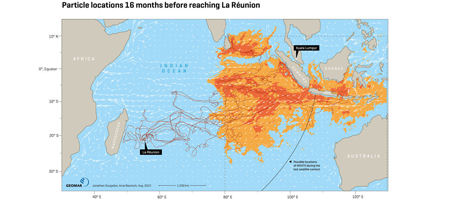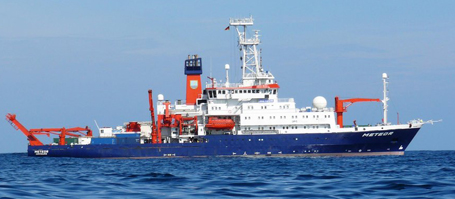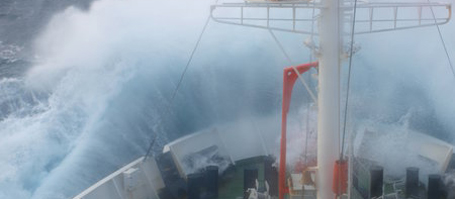The results of their recently completed computer model simulations show that the debris found on La Réunion probably originates from the eastern equatorial Indian Ocean. However, uncertainties in further restricting the area are still very large.
Flight MH370 that disappeared from radar screens on 8 March 2014 seemed to have been ripped off the face of the Earth. Not even a small piece of the Malaysia Airlines Boeing 777 was discovered despite an intensive search in the eastern Indian Ocean off the coast of Australia. The discovery at the end of July 2015 of a part belonging to an aircraft’s wing brought renewed hope. The flaperon was found several thousand kilometres away from the suspected crash site on the island La Réunion. Meanwhile, it is almost certain that this part belongs to MH370. Will the flaperon be the key to localize the crash site of the demised aircraft? Immediately after the discovery, oceanographers from Kiel started to track back the possible drift of the flaperon within a computer model to narrow down the area of the crash. The results show that the crash site could be found further north than previously thought; but also how difficult it will be to localize the aircraft, even with this new piece of information,
Dr. Jonathan Durgadoo and Prof. Dr. Arne Biastoch from GEOMAR Helmholtz Centre for Ocean Research Kiel used a state-of-the-art ocean model in combination with observational data. This provides a coherent realistic dataset for their drift analyses to determine the possible origin of the flaperon. To do so, they release virtual particles around La Réunion and compute their trajectories back in time. "Of course it does not make much sense just to track only a few particles within the model," Dr. Durgadoo explains. "We have traced back almost two million 'virtual' particles over a period of 16 months," Durgadoo continues. "For each month back, we subsequently calculated the probable region of the particles positions."
From this exercise, a very large region in the eastern equatorial Indian Ocean emerged as the most likely area where the flaperon could originate. It extends from the western coasts of Sumatra and Java, about 6,000 kilometers from La Réunion. "Qualitatively, the results correspond to my initial estimates, they are now confirmed by the complex flow analysis", says Professor Biastoch. In addition, all particles originate from a region equatorward of 30oS. "Our findings therefore show that the ongoing search southwest of Australia might be too far south" Dr. Durgadoo comments. However, he admits that on the basis of only a single piece of debris, a more precise delimitation of the area is currently not possible. "Finding more pieces of MH370 debris would be necessary in order to make more precise statements," Professor Biastoch summarizes. In the coming weeks, in order to further refine their statements, the researchers want to consider other processes, such as wind and waves, which are possibly also relevant to further refine the analysis.
Figure in printable resolution: Possible locations of model particles that originate from the eastern Indian Ocean and reach the island of La Réunion 16 months later. The areas with the highest probabilities are color coded. Source: GEOMAR.
Kontakt:
Dr. Andreas Villwock (GEOMAR, Kommunikation & Medien),
Tel.: 0431 600-2802
presse@geomar.de
…



